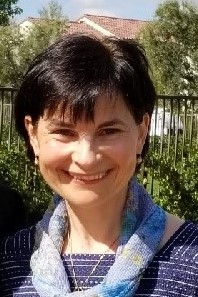EDITOR’S NOTE: We’re thrilled to introduce Andrea Lewis, the newest member of the O.C. Writers’ Leadership Team. Beginning today, she’ll offer insight and advice on the art and craft of writing in the monthly THE WRITING WORKSHOP column. Welcome aboard, Andrea!
By Andrea Lewis //
Have you ever sat and stared at that blank page or screen, zoomed out, waiting for writing to happen?
No? Then you are among the lucky ones. Although, as Anne Lamott puts it in Bird by Bird: Some Instructions on Writing and Life (1995), “writer’s block is going to happen to you,” so you may want to keep reading.
Yes? Then, fellow writers, let’s explore what can be done to overcome the “b-word,” the “dry spell” or the “noonday devil”— terms psychologist Lawrence R. Samuel used to refer to this phenomenon in A Brief History of Writer’s Block on the Psychology Today website.
GETTING UNSTUCK
Wouldn’t it be nice if there was one method, one panacea, to get us unstuck, or, as Lamott suggests in Bird by Bird, to fill up our reservoirs? Fortunately, there’s not just one method, there are many because, as we are about to find out, a block may have different causes for different writers, and even different causes for different projects for the same writer.
It is comforting, however, to learn that writer’s block “is common among writers,” as Neil Gaiman, author of Coraline and others assures us in his Masterclass, and that, thanks to writers who have shared their ways of getting unstuck, we can adopt similar methods.
Like a recipe, before we start cooking, we need to know the ingredients first—why and how blocks happen to us, so that we may take the right actions. For this, we have two sources from where we can draw inspiration to combat writer’s block: the field of psychology and other writers who have tackled the problem themselves.
THE PSYCHOLOGY OF WRITER’S BLOCK
Psychologists paid increased attention to the b-word in the latter part of the 20th century, roughly coinciding with “the rise of the self-help movement” and of “the therapy-oriented culture in the 1970s,” according to Samuel. The possible causes he identified were “fear of failure,” “fear of success,” and “an immobilizing degree of perfectionism.” Yet, sometimes, it was more likely that “the writer was simply unclear about the direction his or her project should go.”
In his article, Samuel notes that in some instances writer’s block can be likened to a struggle with addiction—putting the task off, denying the problem, then never actually finding oneself in the mood to write.
To overcome this obstacle, it’s important for a writer to maintain confidence in their work. “One good way [to overcome writer’s block] was to eliminate any and all forms of criticism during the creative process,” he advises. “No idea was [a] bad [idea] as long as words appeared on paper. The writers would make it a rule to not allow themselves to revise, correct or edit a first draft when experiencing a block. When pressure gets to them, writers should keep in mind that they do not have to get it right the first time.”
Samuel also lists these additional methods:
- Writing down anything that one does in a 24-hour period, which will put the brain into a writing mode which could transition into more creative territory, thus easing the fear of the blank page;
- Pretending to abandon the idea of writing a whole book. Instead, a writer could focus on writing one word or sentence. This could be especially useful for novelists who aren’t sure which direction their stories should go.
EXPERIENCE COUNTS
As for writers who have shared their experiences with writer’s block, some don’t believe it exists, some have identified a cause and devised a solution, and others employ a cure that feels best for them in the moment.
In Why We Write (2013) by Meredith Maran, Isabel Allende, author of Paula, advises: “Show up, show up, show up and after a while, the muse shows up, too. If she doesn’t show up invited, eventually she just shows up.” After she wrote Paula, a memoir about her daughter, Allende suffered from writer’s block. During a trip to India, she learned not to focus on herself. At home, still unable to write fiction, Allende gave herself a task: write about anything except politics and football. She wrote Aphrodite, a nonfiction book about sex and gluttony, A Memoir of the Senses.
Faced with the challenge, Allende switched gears and wrote something else. That kept her writing. Her advice of “showing up” refers to a writer’s commitment to their calling, but it also asks writers to adopt a certain structure to their daily life, giving the act of writing a dedicated time and space.
We can find the same idea with Judy Blume, author of Are You There, God? It’s Me, Margaret. In her Masterclass, Blume reveals that she doesn’t believe in writer’s block and instead advises writers to take themselves seriously as writers. “Treat writing as your job, make time for it,” she encourages. “Instead of giving up when you hit an obstacle, write something else or go back to your notebooks to regain your momentum. Get away from your desk. Do the laundry. Go for a walk. […] Make some space for your personal life, […]. Remember that real-life events and observations are key to keeping your idea box full.”
James Patterson, author of the Alex Cross series, recommends that writers do not torture themselves, do not obsess over “a scene, chapter, or even a single sentence”—that is what leads to blocks. His key to warding off writer’s block is to “freight train through that first draft. Get that story down.” When stuck, “write TBD on that chapter and move on.” He sometimes has TBD written on two or three chapters in a row. “It’s ok to move on and come back to it later,” he urges in his Masterclass.
Author of The Handmaid’s Tale, Margaret Atwood, advises writers to keep their hand in the writing process, whether the writing feels like it’s going smoothly or not. Even if those words or pages don’t make it into a final draft, they will teach and generate the momentum that will help writers complete each project and start new ones.
Atwood’s advice dovetails with James Patterson’s wisdom when she advises writers to be kind to themselves and remember to take breaks and walk around because ideas “may come to you while you are walking that don’t come while you’re hunched over the computer,” she says. More importantly, she adds in her Masterclass that writers should “take some time off” to allow themselves to recharge physically and mentally.
In Bird by Bird, Lamott identifies acceptance as the problem: “if you accept the reality […] that you are not in a productive creative period—you free yourself to begin filling up again.” She encourages her students to write, on days like that, 300 words on how much they hate writing. Her advice echoes the advice of others to write about anything as long as the writing happens.
In close connection to the psychological finds mentioned by Samuel, Gaiman, in his Masterclass, shares his belief in the necessity of identifying the cause so writers can emerge from the “overwhelming feeling of being stuck.” Through a series of questions that writers should consider when stuck, Gaiman suggests possible causes of the block. Here’s a couple:
- “Is it an earlier decision you made in the manuscript?” Take a break, come back with a fresh eye, start reading from the beginning and “where the story should be becomes obvious.”
- Are you trying to force a situation on a character when that character wants to do something else? Are you listening to your characters? “If your characters have stopped ‘talking’ to you, write the next thing you know that happens in your story. Writing doesn’t have to happen chronologically.”
FIND WHAT WORKS FOR YOU
Writer’s block is common. The writing process is individual. We gather great advice from writers who have come before us. Yet, eventually, we are alone in front of the screen or page, often without a clue how to take the next step. However, I found great help when reaching out to a community of writers, critique groups, workshops, circles where writers share their work. Giving and receiving feedback helped me see my work from different points of view. Questions that I received within workshops showed me parts where my piece was unclear. Suggestions helped me improve my piece, thus helped me publish.
Remember: There is always someone who has already experienced what we are going through in our writing journey. O.C. Writers is a good place to get such help. I did, and I am honored to be part of it.
Whether you decide to follow the science behind writers’ blocks, act empirically upon your own, or follow the advice of beloved authors, you’ll ultimately have to decide what works best for you. And if nothing seems to work, perhaps a mantra borrowed from Lamott will help: “live as if we are dying [because] it gives us a chance to experience some real presence.” Participating in ordinary life will begin the process of filling up the reservoirs of “observations, flavors, ideas, visions, memories.”

ANDREA LEWIS lives and writes in Huntington Beach. She was born in Romania and moved to the United States at the age of 34, after meeting and marrying her husband. She writes memoir and personal essays, with a recent attempt at freeform poetry. Her work has been featured in the Los Angeles Times.


Very useful article. Encouraging, really. Thank you !
Thank you, Charmaine, I appreciate your kind words and I hope that the articles helped you. Andrea
Excellent article containing excellent advice. I’ve long been a fan of the “write about anything as long as the writing happens” strategy. Amazing what can happen when we get out of our own way. 🙂
Yes, that is true! I’ve applied it, and it works. If only, I applied it every day! Thank you for your kind words, Barbara!